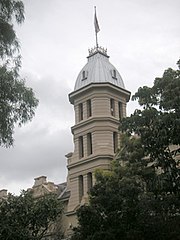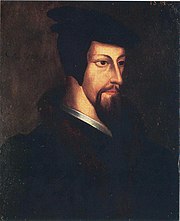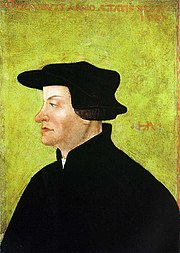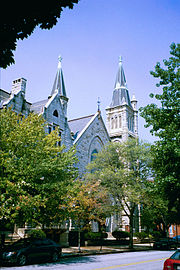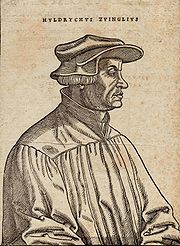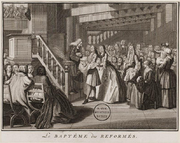Usage
- Add a new Selected article to the next available subpage.
- Update "max=" to new total for its {{Random portal component}} on the main page.
Selected articles list
Portal:Calvinism/Selected article/1
The school in New South Wales.
Founded in 1888 by a committee of the
Reception (4 years old) to Year 12 (18 years old), including 70 boarders. Student's attend P.L.C from all regions of the greater
metropolitan area, New South Wales country regions, and overseas.
Formerly a school of the Presbyterian Church, Pymble Ladies' College is P.L.C's 'daughter school' in Pymble.
More selected articles... |
|
Portal:Calvinism/Selected article/2
Protestant Reformation and he is considered the founder of the
Presbyterian denomination. He was educated at the
University of St Andrews and worked as a notary-priest. Influenced by early church reformers such as
George Wishart, he joined the movement to reform the Scottish church. He was caught up in the ecclesiastical and political events that involved the murder of
Cardinal Beaton in 1546 and the intervention of the
regent
When
James VI
enthroned in her stead, he openly attacked her in sermons. He continued to preach until his final days.
More selected articles... |
|
Portal:Calvinism/Selected article/3
Calvinism or Reformed theology. In
Geneva, his ministry both attracted other Protestant refugees and over time made that city a major force in the spread of Reformed theology. He is renowned for his teachings and writings, in particular for his
Institutes of the Christian Religion
Calvin's father was an attorney and in 1523 sent his fourteen-year-old son to the University of Paris to study humanities and law. His Protestant friends included Nicholas Cop, Rector at the University of Paris. In 1533 Cop gave an address "replete with Protestant ideas," and "Calvin was probably involved as the writer of that address." Calvin later settled for a time in Basel, where in 1536 he published the first edition of his Institutes. John Calvin died in Geneva on May 27, 1564. He was buried in the Cimetière des Rois under a tombstone marked simply with the initials "J.C.", partially honoring his request that he be buried in an unknown place, without witnesses or ceremony.
More selected articles... |
|
Portal:Calvinism/Selected article/4
.
More selected articles... |
|
Portal:Calvinism/Selected article/5
King James Bible, considered a masterpiece of Jacobean prose. In Scotland, James attempted to bring the Scottish kirk "so neir as can be" to the English church and reestablish the episcopacy, a policy which met with strong opposition. In 1618, James's bishops forced his
Five Articles of Perth
More selected articles... |
|
Portal:Calvinism/Selected article/6
Reformed churches
of today.
More selected articles... |
|
Portal:Calvinism/Selected article/7
Presbyterian
church located at Park and Lafayette Avenues in the city's
Bolton Hill section. The church is noted for its ornate
stained glass windows by the renowned artist
Louis Comfort Tiffany, soaring vaulted ceiling, and prominent persons associated with its history. Maltbie Babcock, who was the church's pastor 1887–1900, wrote the familiar hymn,
This is My Father's World. Storied virtuoso concert performer
Virgil Fox
A portion of the congregation decided in 1956 to build a church in the suburban Woodbrook area north of Baltimore. Others members wished to remain at the Bolton Hill location, prompting a decision to operate one church at two locations, with a shared ministerial staff. This arrangement continued until 1980, when the congregations of the two churches voted for separation. The original Bolton Hill church was subsequently referred to as "Brown Memorial Park Avenue", to distinguish it from "Brown Memorial Woodbrook".
More selected articles... |
|
Portal:Calvinism/Selected article/8
The basis of the
canonical gospels
.
He developed the symbolic view of the Eucharist. He denied the Catholic doctrine of
Cornelius Henrici Hoen, he agreed that the bread and wine of the institution signify and does not literally become the body and blood of Christ. Zwingli’s differences of opinion on this with
Martin Luther resulted in the failure of the
Marburg Colloquy to bring unity between the two Protestant leaders.
Zwingli believed that the state governed with divine sanction. He believed that both the church and the state are placed under the sovereign rule of God. Christians were obliged to obey the government, but civil disobedience was allowed if the authorities acted against the will of God. He described a preference for an aristocracy over monarchic or democratic rule.
More selected articles... |
|
Portal:Calvinism/Selected article/9
The in the seventeenth and eighteenth centuries. The Confession became influential throughout the English-speaking world, but especially in American Protestant theology.
More selected articles... |
|
Portal:Calvinism/Selected article/10
, became a standard Reformed theological textbook.
Vermigli's best-known theological contribution was defending the
Heaven
even though he is offered to those who partake of the Eucharist and received by believers.
More selected articles... |
|
Portal:Calvinism/Selected article/11
The Reverend , church history and government.
More selected articles... |
|
Portal:Calvinism/Selected article/12
In
Reformed theology,
baptism is a
sacrament signifying the baptized person's
union with Christ, or becoming part of Christ and being treated as if they had done everything Christ had. Sacraments, along with preaching of God's word, are
means of grace through which God offers Christ to people. Sacraments are believed to have their effect through the
Holy Spirit, but these effects are only believed to be beneficial to those who have faith in Christ.
In Reformed theology, baptism is the sacrament of initiation into the
visible church, or body of people who publicly claim faith in Christ. Baptism also signifies
regeneration and remission of sin. Reformed Christians believe that the children of those who express
faith in Christ should be baptized. Because baptism is believed to be beneficial only to those who have faith in Christ, infants are baptized on the basis of the promise of faith which will come to fruition later in life.
More selected articles... |
|
Portal:Calvinism/Selected article/13
Anglican Church
and preach in a simpler, more consensual manner. Though he felt the English church needed significant reforms, he nevertheless was adamant about not separating from it; his preference was to change it from within. While many ministers were removed from their pulpits for their puritan practices, Cotton thrived at St. Botolph's for nearly 20 years because of supportive aldermen, lenient bishops, and his very conciliatory and gentle demeanor. By 1632, however, the Anglican church had greatly increased its pressure on the non-conforming clergy, and Cotton was forced to go into hiding. The following year he and his wife boarded a ship for New England.
More selected articles... |
|
Portal:Calvinism/Selected article/14
schism
that threatened to destroy the Puritans' religious community in New England. She was eventually tried and convicted, then banished from the colony with many of her supporters.
Hutchinson is a key figure in the development of religious freedom in England's American colonies and the history of women in ministry. She challenged the authority of the ministers, exposing the subordination of women in the culture of colonial Massachusetts. She is honoured by Massachusetts with a State House monument calling her a "courageous exponent of civil liberty and religious toleration." She has been called the most famous, or infamous, English woman in colonial American history.
More selected articles... |
|
Portal:Calvinism/Selected article/15
from 1652 and the imposition of religious toleration for Protestants. The Scottish Covenanters divided into parties of Resolutioners and Protesters.
More selected articles... |
|
Portal:Calvinism/Selected article/16
Evangelicals and the
Moderate Party. The legal right of
lay patrons to present clergymen of their choice to local ecclesiastical livings led to minor schisms from the church. The first in 1733, known as the
First Secession and headed by figures including
Ebenezer Erskine, led to the creation of a series of secessionist churches. The second in 1761 led to the foundation of the independent
Relief Church
More selected articles... |
|
Portal:Calvinism/Selected article/17
Presbyterian Church. He spent 20 years in Africa, primarily in and around the
Congo Free State, and is best known for his efforts to publicize the atrocities committed against the
Kuba and other Congolese peoples by
King Leopold II's
Force Publique
Sheppard's efforts contributed to the contemporary debate on European colonialism and imperialism in the region, particularly amongst those of the African American community. However, it has been noted that he traditionally received little attention in literature on the subject.
More selected articles... |
|
Portal:Calvinism/Selected article/18
Puritan clergyman in England and America, and was most noted for being banished from the
Massachusetts Bay Colony during the
Antinomian Controversy, and for subsequently establishing the town of
Exeter, New Hampshire. Born in
Lincolnshire, England, he was raised in a family with substantial means, and received both a B.A. and M.A. at
Sidney Sussex College, Cambridge where he was a noted athlete and where
Oliver Cromwell was a college friend. Ordained in 1619, he became the vicar of the church in
Bilsby, Lincolnshire, and held this position for ten years until removed for
simony
More selected articles... |
|
Portal:Calvinism/Selected article/19
Queens, New York
.
More selected articles... |
|
Portal:Calvinism/Selected article/20
, in which the king was considered sovereign over the Church within his realm.
During Cranmer's tenure as Archbishop of Canterbury, he was responsible for establishing the first doctrinal and liturgical structures of the reformed Church of England. Under Henry's rule, Cranmer did not make many radical changes in the Church, due to power struggles between religious conservatives and reformers. However, he succeeded in publishing the first officially authorised vernacular service, the Exhortation and Litany.
More selected articles... |
|
Nominations
Feel free to add Featured, or GA Calvinism articles to the above list. Other Calvinist articles may be nominated here.
Current nominations
Choose the next "Selected article":

